Ag Nanoparticles Stabilized on Cyclodextrin Polymer Decorated with Multi-Nitrogen Atom Containing Polymer: An Efficient Catalyst for the Synthesis of Xanthenes
Abstract
1. Introduction
2. Result and Discussion
2.1. Characterization of Ag@CDNS-N/PMelamine
2.2. Study of the Catalytic Performance
2.3. Reaction Mechanism
2.4. Catalyst Recyclability
3. Experimental
3.1. Materials and Instrumentation
3.2. Synthesis of the Catalyst
3.2.1. Synthesis of CDNS
3.2.2. Synthesis of Amine-Functionalized CDNS (CDNS-N)
3.2.3. Growing Polymer on CDNS (CDNS-N/PMelamine)
3.2.4. Preparations of Cuscuta Epithymum Extract
3.2.5. Synthesis of Ag NPs and Their Embedding into CDNS-N/PMelamine: Synthesis of Ag@CDNS-N/PMelamine
3.3. General Procedure for the Synthesis Xanthenes Derivative
4. Conclusions
Supplementary Materials
Author Contributions
Funding
Acknowledgments
Conflicts of Interest
References
- Roucoux, A.; Schulz, J.; Patin, H. Reduced Transition Metal Colloids: A Novel Family of Reusable Catalysts? Chem. Rev. 2002, 102, 3757–3778. [Google Scholar] [CrossRef]
- Zahmakıran, M.; Özkar, S. Metal Nanoparticles in Liquid Phase Catalysis; from Recent Advances to Future Goals. Nanoscale 2011, 3, 3462–3481. [Google Scholar] [CrossRef]
- Sadjadi, S.; Majid, M.H.; Malmir, M. Pd (0) Nanoparticle Immobilized on Cyclodextrin-Nanosponge-Decorated Fe2O3@ SiO2 core-shell Hollow Sphere: An Efficient Catalyst for CC Coupling Reactions. J. Taiwan Inst. Chem. Eng. 2018, 86, 240–251. [Google Scholar] [CrossRef]
- Russo, M.; Spinella, A.; Di Vincenzo, A.; Lazzara, G.; Correro, M.R.; Shahgaldian, P.; Lo Meo, P.; Caponetti, E. Synergistic Activity of Silver Nanoparticles and Polyaminocyclodextrins in Nanosponge Architectures. ChemistrySelect 2019, 4, 873–879. [Google Scholar] [CrossRef]
- Bouchenafa-Saib, N.; Grange, P.; Verhasselt, P.; Addoun, F.; Dubois, V. Effect of Oxidant Treatment of Date Pit Active Carbons Used as Pd Supports in Catalytic Hydrogenation of Nitrobenzene. Appl. Catal. A: Gen. 2005, 286, 167–174. [Google Scholar] [CrossRef]
- Yu, X.; Wang, M.; Li, H. Study on the Nitrobenzene Hydrogenation Over a Pd-B/SiO2 Amorphous Catalyst. Appl. Catal. A: Gen. 2000, 202, 17–22. [Google Scholar] [CrossRef]
- Giordano, R.; Serp, P.; Kalck, P.; Kihn, Y.; Schreiber, J.; Marhic, C.; Duvail, J.-L. Preparation of Rhodium Catalysts Supported on Carbon Nanotubes by a Surface Mediated Organometallic Reaction. Eur. J. Inorg. Chem. 2003, 2003, 610–617. [Google Scholar] [CrossRef]
- Li, C.-H.; Yu, Z.-X.; Yao, K.-F.; Ji, S.-F.; Liang, J. Nitrobenzene Hydrogenation with Carbon Nanotube-Supported Platinum Catalyst under Mild Conditions. J. Mol. Catal. A: Chem. 2005, 226, 101–105. [Google Scholar] [CrossRef]
- Arora, N.; Mehta, A.; Mishra, A.; Basu, S. 4-Nitrophenol Reduction Catalysed by Au-Ag Bimetallic Nanoparticles Supported on LDH: Homogeneous vs. Heterogeneous Catalysis. Appl. Clay Sci. 2018, 151, 1–9. [Google Scholar] [CrossRef]
- Hapiot, F.; Bricout, H.; Menuel, S.; Tilloy, S.; Monflier, E. Recent Breakthroughs in Aqueous Cyclodextrin-Assisted Supramolecular Catalysis Catal. Sci. Technol. 2014, 4, 1899–1908. [Google Scholar]
- Hapiot, F.; Monflier, E. Unconventional Approaches Involving Cyclodextrin-Based, Self-Assembly-Driven Processes for the Conversion of Organic Substrates in Aqueous Biphasic Catalysis. Catalysts 2017, 7, 173. [Google Scholar] [CrossRef]
- Prochowicz, D.; Kornowicz, A.; Lewiński, J. Interactions of Native Cyclodextrins with Metal Ions and Inorganic Nanoparticles: Fertile Landscape for Chemistry and Materials Science. Chem. Rev. 2017, 117, 13461–13501. [Google Scholar] [CrossRef] [PubMed]
- Herbois, R.; Noël, S.; Léger, B.; Tilloy, S.; Menuel, S.; Addad, A.; Martel, B.; Ponchel, A.; Monflier, E. Ruthenium-Containing β-cyclodextrin Polymer Globules for the Catalytic Hydrogenation of Biomass-Derived Furanic Compounds. Green Chem. 2015, 17, 2444–2454. [Google Scholar] [CrossRef]
- Noël, S.; Léger, B.; Ponchel, A.; Philippot, K.; Denicourt-Nowicki, A.; Roucoux, A.; Monflier, E. Cyclodextrin-based systems for the stabilization of metallic (0) nanoparticles and their versatile applications in catalysis. Catal. Today 2014, 235, 20–32. [Google Scholar] [CrossRef]
- Pourjavadi, A.; Keshavarzi, N.; Moghaddam, F.M.; Hosseini, S.H. Immobilization of Nickel Ions onto the Magnetic Nanocomposite Based on Cross-Linked Melamine Groups: Effective Heterogeneous Catalyst for N-Arylation of Arylboronic Acids. Appl. Organomet. Chem. 2018, 32, e4107. [Google Scholar] [CrossRef]
- Pourjavadi, A.; Tajbakhsh, M.; Farhang, M.; Hosseini, S.H. Copper-loaded Polymeric Magnetic Nanocatalysts as Retrievable and Robust Heterogeneous Catalysts for Click Reactions. New J. Chem. 2015, 39, 4591–4600. [Google Scholar] [CrossRef]
- Pourjavadi, A.; Hosseini, S.H.; Moghaddam, F.M.; Ayati, S.E. Copper Loaded Cross-Linked Poly (Ionic Liquid): Robust Heterogeneous Catalyst in ppm Amount. RSC Adv. 2015, 5, 29609–29617. [Google Scholar] [CrossRef]
- Khan, A.R.; Forgo, P.; Stine, K.J.; D’Souza, V.T. Methods for Selective Modifications of Cyclodextrins. Chem. Rev. 1998, 98, 1977–1996. [Google Scholar] [CrossRef]
- Sharma, V.K.; Yngard, R.A.; Lin, Y. Silver Nanoparticles: Green Synthesis and their Antimicrobial Activities. Adv. Colloid Interface Sci. 2009, 145, 83–96. [Google Scholar] [CrossRef]
- Prow, T.W.; Grice, J.E.; Lin, L.L.; Faye, R.; Butler, M.; Becker, W.; Wurm, E.M.T.; Yoong, C.; Robertson, T.A.; Soyer, H.P. Nanoparticles and Microparticles for Skin Drug Delivery. Adv. Drug Deliv. Rev. 2011, 63, 470–491. [Google Scholar] [CrossRef]
- Kelly, F.M.; Johnston, J.H. Colored and Functional Silver Nanoparticle-Wool Fiber Composites. ACS Appl. Mater. Interfaces 2011, 3, 1083–1092. [Google Scholar] [CrossRef] [PubMed]
- Cheng, F.; Betts, J.W.; Kelly, S.M.; Schaller, J.; Heinze, T. Synthesis and Antibacterial Effects of Aqueous Colloidal Solutions of Silver Nanoparticles Using Aminocellulose as a Combined Reducing and Capping Reagent. Green Chem. 2013, 15, 989–998. [Google Scholar] [CrossRef]
- Shahriary, M.; Veisi, H.; Hekmati, M.; Hemmati, S. In Situ Green Synthesis of Ag Nanoparticles on Herbal Tea Extract (Stachys lavandulifolia)-Modified Magnetic Iron Oxide Nanoparticles as Antibacterial Agent and their 4-nitrophenol Catalytic Reduction Activity. Mater. Sci. Eng. C 2018, 90, 57–66. [Google Scholar] [CrossRef] [PubMed]
- Zelefack, F.; Guilet, D.; Fabre, N.; Bayet, C.; Chevalley, S.; Ngouela, S.; Lenta, B.N.; Valentin, A.; Tsamo, E.; Dijoux-Franca, M.G. Cytotoxic and Antiplasmodial Xanthones from Pentadesma butyracea. J. Nat. Prod. 2009, 72, 954–957. [Google Scholar] [CrossRef]
- Nguyen, H.T.; Lallemand, M.C.; Boutefnouchet, S.; Michel, S.; Tillequin, F. Antitumor Psoropermum Xanthones and Sarcomelicope Acridones: Privileged Structures Implied in DNA Alkylation. J. Nat. Prod. 2009, 72, 527–539. [Google Scholar] [CrossRef]
- Ion, R.M.; Planner, A.; Wiktorowicz, K.; Frackowiak, D. The Incorporation of Various Porphyrins into Blood Cells Measured Via Flow Cytometry, Absorption and Emission Spectroscopy. Acta Biochim. 1998, 45, 833–845. [Google Scholar] [CrossRef]
- Saint-Ruf, G.; Hieu, H.T.; Poupelin, J.P. The Effect of Dibenzoxanthenes on the Paralyzing Action of Zoxazolamine. Naturwissenschaften 1975, 62, 584–585. [Google Scholar] [CrossRef]
- Li, J.; Lu, L.; Su, W. A new Strategy for the Synthesis of Benzoxanthenes Catalyzed by Proline Triflate in Water. Tetrahedron Lett. 2010, 51, 2434–2437. [Google Scholar] [CrossRef]
- Yue, X.; Wu, Z.; Wang, G.; Liang, Y.; Sun, Y.; Song, M.; Zhan, H.; Bi, S.; Liu, W. High Acidity Cellulose Sulfuric Acid from Sulfur Trioxide: A highly Efficient Catalyst for the One Step Synthesis of Xanthene and Dihydroquinazolinone Derivatives. RSC Adv. 2019, 9, 28718–28723. [Google Scholar] [CrossRef]
- Bitaraf, M.; Amoozadeh, A.; Otokesh, S. Nano-WO3-Supported Sulfonic Acid: A Versatile Catalyst for the One-Pot Synthesis of 14-Aryl-14H-dibenzo[a,j]xanthene Derivatives Under Solvent-Free Conditions. Proc. Natl. Acad. Sci. India Sect. A Phys. Sci. 2019, 89, 437–443. [Google Scholar] [CrossRef]
- Salami, M.; Ezabadi, A. A Caffeine-Based Ionic Liquid as a Novel and Eco-Friendly Catalyst for the Synthesis of 1,8-dioxo-octahydroxanthenes under Solvent-Free Conditions. Res. Chem. Intermed. 2019, 45, 3673–3686. [Google Scholar] [CrossRef]
- Amoozadeh, A.; Hosseininya, S.F.; Rahmani, S. Nano Titania-Supported Sulfonic Acid (n-TSA) as an Efficient, Inexpensive, and Reusable Catalyst for One-Pot Synthesis of 1, 8-dioxo-octahydroxanthene and Tetrahydrobenzo[b]pyran Derivatives. Res. Chem. Intermed. 2018, 44, 991–1011. [Google Scholar] [CrossRef]
- Naeimi, H.; Nazifi, Z.S. A highly Efficient nano-Fe3O4 encapsulated-silica Particles Bearing Sulfonic Acid Groups as a Solid Acid Catalyst for Synthesis of 1,8-dioxo-octahydroxanthene Derivatives. J. Nanopart Res. 2013, 15, 2026–2037. [Google Scholar] [CrossRef] [PubMed]
- Niknam, N.; Panahi, F.; Saberi, D.; Mohagheghnejad, M. Silica-BondedS-Sulfonic Acid as Recyclable Catalyst for the Synthesis of 1,8-Dioxo-decahydroacridines and 1,8-Dioxo-octahydroxanthenes. J. Heterocycl. Chem. 2010, 47, 292–300. [Google Scholar]
- Rashedian, F.; Saberi, D.; Niknam, K. Silica-bondedN-Propyl Sulfamic Acid: A Recyclable Catalyst for the Synthesis of 1,8-Dioxo-decahydroacridines, 1,8-Dioxo-octahydroxanthenes and Quinoxaline. J. Chin. Chem. Soc. 2010, 57, 998–1006. [Google Scholar] [CrossRef]
- Sadjadi, S.; Malmir, M.; Heravi, M.M.; Raja, M. Magnetic Hybrid of Cyclodextrin Nanosponge and Polyhedral Oligomeric Silsesquioxane: Efficient Catalytic Support for Immobilization of Pd Nanoparticles. Int. J. Biol. Macromol. 2019, 128, 638–647. [Google Scholar] [CrossRef]
- Sadjadi, S.; Heravi, M.M.; Malmir, M. Pd@HNTs-CDNS-g-C3N4: A Novel Heterogeneous Catalyst for Promoting Ligand and Copper-Free Sonogashira and Heck Coupling Reactions, Benefits from Halloysite and Cyclodextrin Chemistry and g-C3N4 Contribution to Suppress Pd leaching. Carbohydr. Polym. 2018, 186, 25–34. [Google Scholar] [CrossRef]
- Sadjadi, S.; Heravi, M.M.; Daraie, M. A Novel Hybrid Catalytic System Based on Immobilization of Phosphomolybdic Acid on Ionic Liquid Decorated Cyclodextrin-Nanosponges: Efficient Catalyst for the Green Synthesis of Benzochromeno-Pyrazole through Cascade Reaction: Triply green. J. Mol. Liq. 2017, 231, 98–105. [Google Scholar] [CrossRef]
- Sadjadi, S.; Heravi, M.M.; Raja, M. Composite of Ionic Liquid Decorated Cyclodextrin Nanosponge, Graphene Oxide and Chitosan: A Novel Catalyst Support. Int. J. Biol. Macromol. 2019, 122, 228–237. [Google Scholar] [CrossRef]
- Sadjadi, S.; Heravi, M.M.; Raja, M.; Kahangi, F.G. Palladium Nanoparticles Immobilized on Sepiolite–Cyclodextrin Nanosponge Hybrid: Efficient Heterogeneous Catalyst for Ligand- and Copper-Free C–C Coupling Reactions. Appl. Organomet. Chem. 2018, 32, e4508. [Google Scholar] [CrossRef]
- Malmir, M.; Heravi, M.M.; Sadjadi, S.; Hosseinnejad, T. Ultrasonic and Bio-Assisted Synthesis of Ag@HNTs-T as a Novel Heterogeneous Catalyst for the Green Synthesis of Propargylamines: A Combination of Experimental and Computational Study. Appl. Organomet. Chem. 2018, 32, e4291. [Google Scholar] [CrossRef]
- Sadjadi, S.; Malmir, M.; Heravi, M.M. A Green Approach to the Synthesis of Ag Doped Nano Magnetic γ-Fe2O3@SiO2-CD core–Shell Hollow Spheres as An Efficient and Heterogeneous Catalyst for Ultrasonic-Assisted A3 and KA2 Coupling Reactions. RSC Adv. 2017, 7, 36807–36818. [Google Scholar] [CrossRef]
- Aravinthan, A.; Govarthanan, M.; Selvam, K.; Praburaman, L.; Selvankumar, T.; Balamurugan, R.; Kamala-Kannan, S.; Kim, J.-H. Sunroot Mediated Synthesis and Characterization of Silver Nanoparticles and Evaluation of its Antibacterial and Rat Splenocyte Cytotoxic Effects. Int. J. Nanomed. 2015, 10, 1977. [Google Scholar]
- Krishnaraj, C.; Jagan, E.G.; Rajasekar, S.; Selvakumar, P.; Kalaichelvan, P.T.; Mohan, N. Synthesis of Silver Nanoparticles Using Acalypha Indica Leaf Extracts and its Antibacterial Activity Against Water Borne Pathogens. Colloids Surf. B 2010, 76, 50–56. [Google Scholar] [CrossRef]
- Martin-Trasanco, R.; Cao, R.; Esparza-Ponce, H.E.; García-Pupo, L.; Montero-Cabrera, M.E. Small, Stable and Biocompatible Gold Nanoparticles Capped with a β-cyclodextrin Polymer. RSC Adv. 2015, 5, 98440–98446. [Google Scholar] [CrossRef]
- Jaiswal, S.; Duffy, B.; Jaiswal, A.K.; Stobie, N.; McHale, P. Enhancement of the Antibacterial Properties of Silver Nanoparticles Using β-cyclodextrin as A Capping Agent. Int. J. Antimicrob. Agents 2010, 36, 280–283. [Google Scholar] [CrossRef]
- Sadat, S.N.; HatamJafari, F. One-Pot Synthesis of 1,8-Dioxo-octahydroxanthene Derivatives. Orient. J. Chem. 2015, 31, 191–1193. [Google Scholar] [CrossRef]
- Khoeiniha, R.; Ezabadi, A.; Olyaei, A. An Efficient Solvent-Free Synthesis of 1,8-dioxooctahydroxanthenes Using Fe2(SO4)3.7H2O as Catalyst. Iran. Chem. Commun. 2016, 4, 273–282. [Google Scholar]
- Arzehgar, Z.; Aydi, A.; Mirzaei Heydari, M. Silver Functionalized on Hydroxyapatite-Core-Shell Magnetic γ-Fe2O3: An Enviromentaly and Readily Recyclable Nanatalyst for the One-Pot Synthesis of 14H-dibenzo[a,j]xanthenes derivatives. Asian J. Green Chem. 2018, 2, 281–298. [Google Scholar]
Sample Availability: Samples of CDNS is available from the authors. |
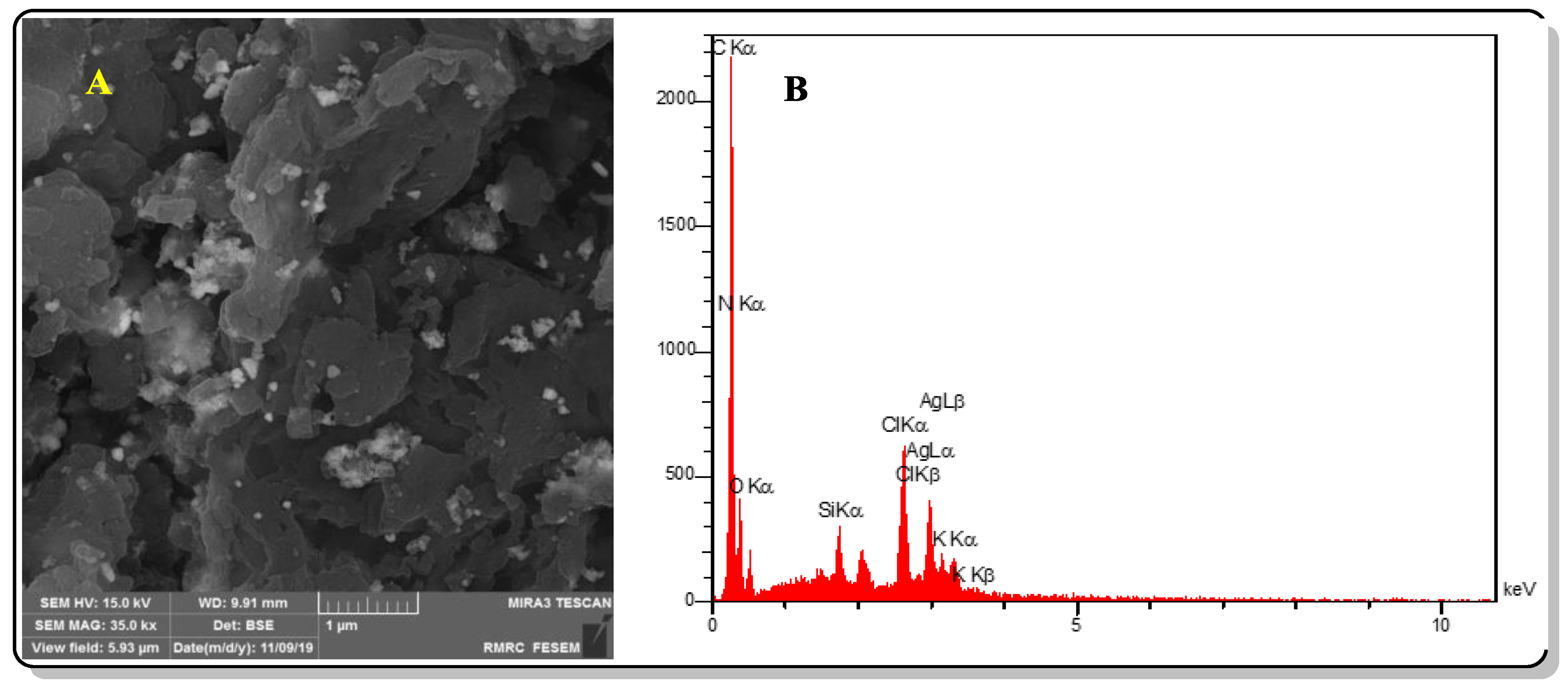
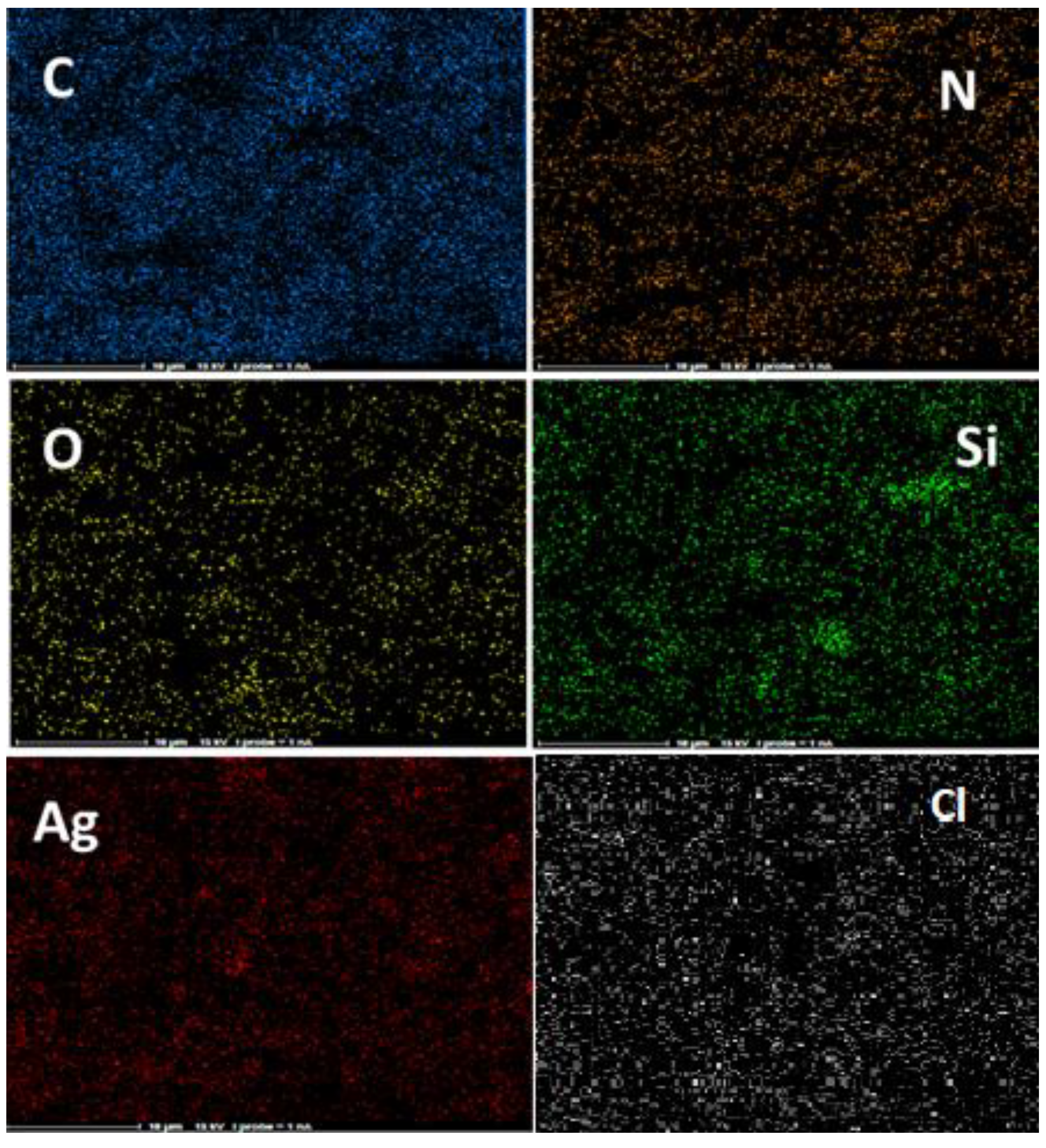

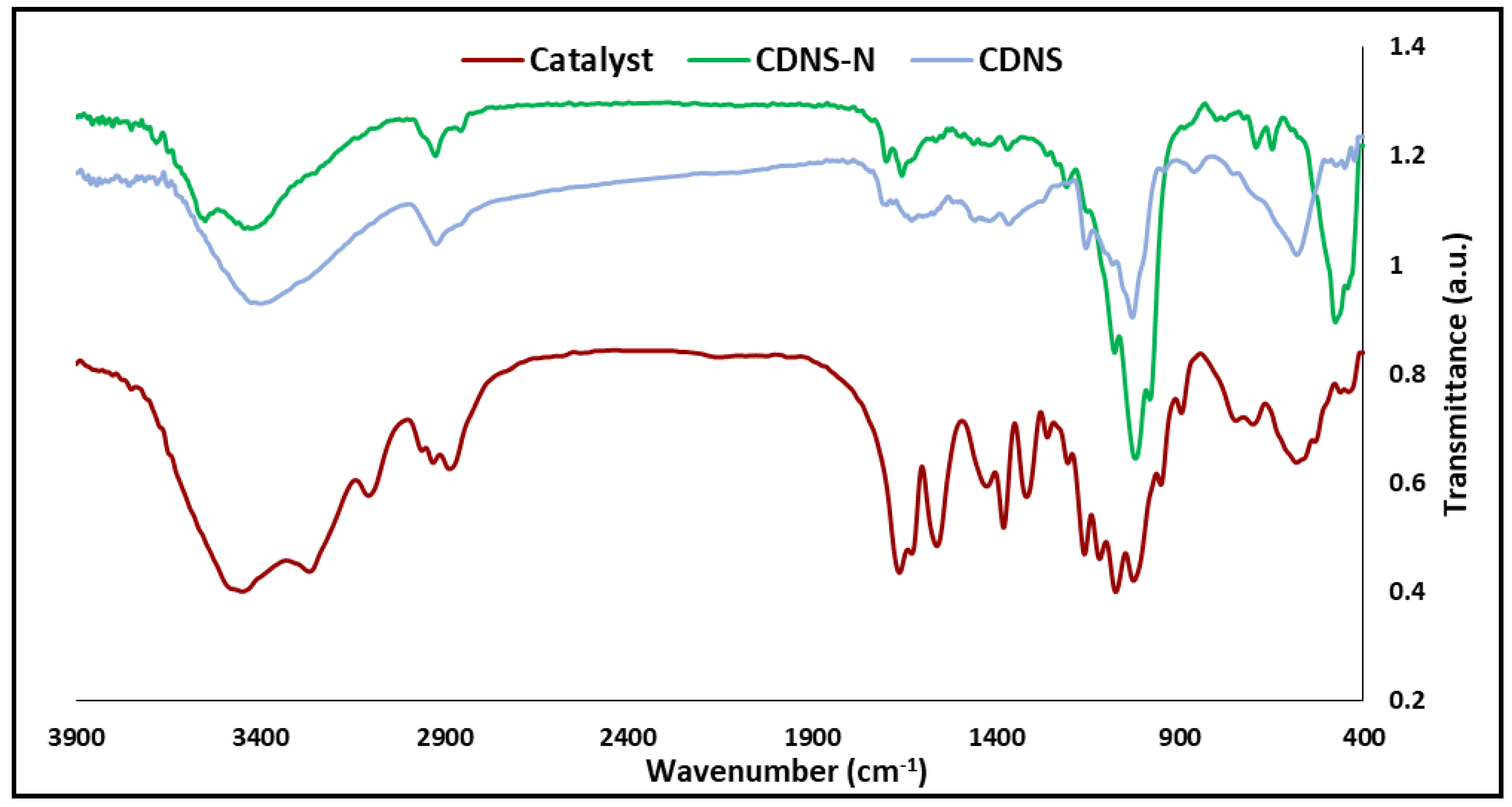

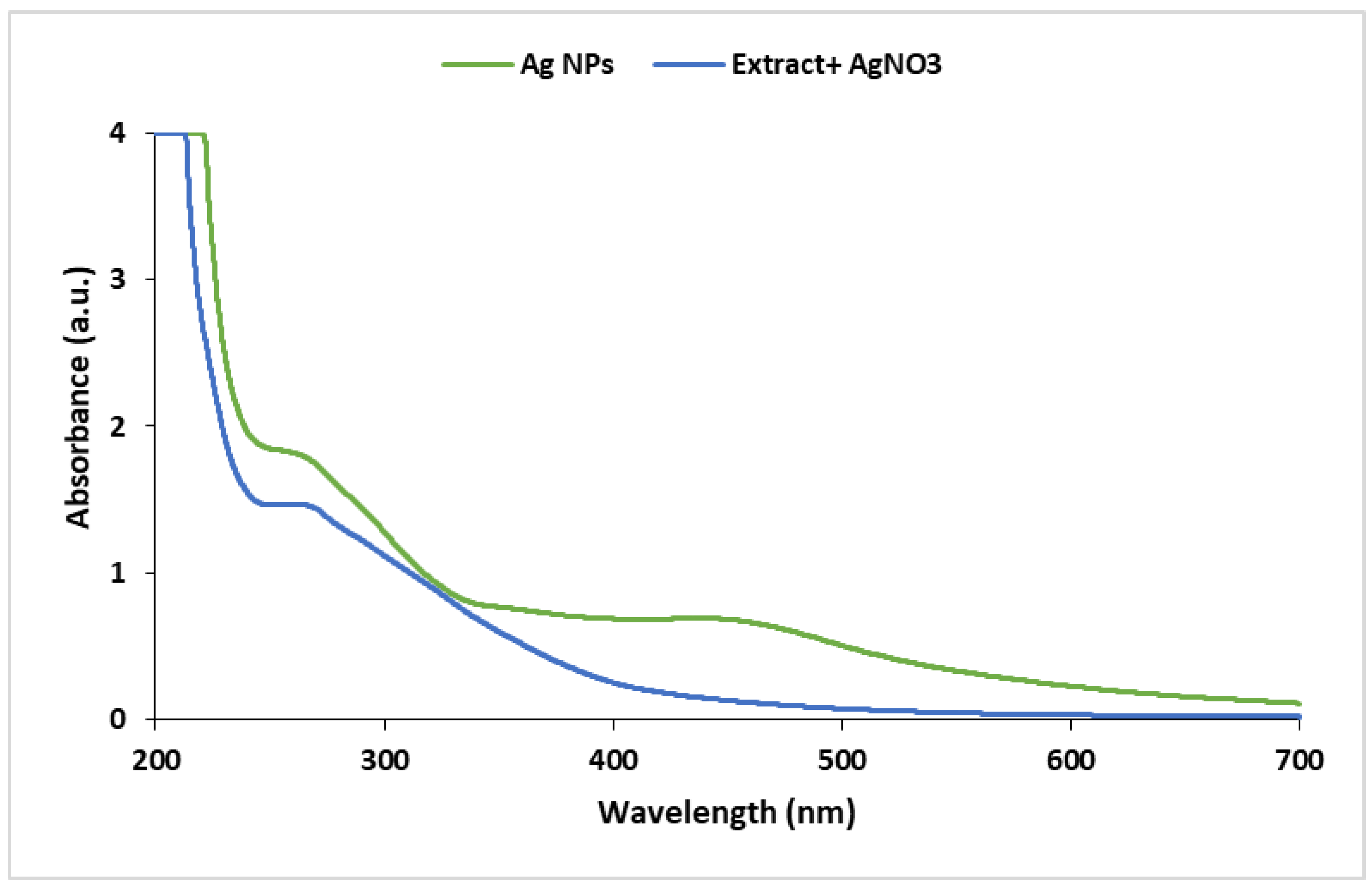
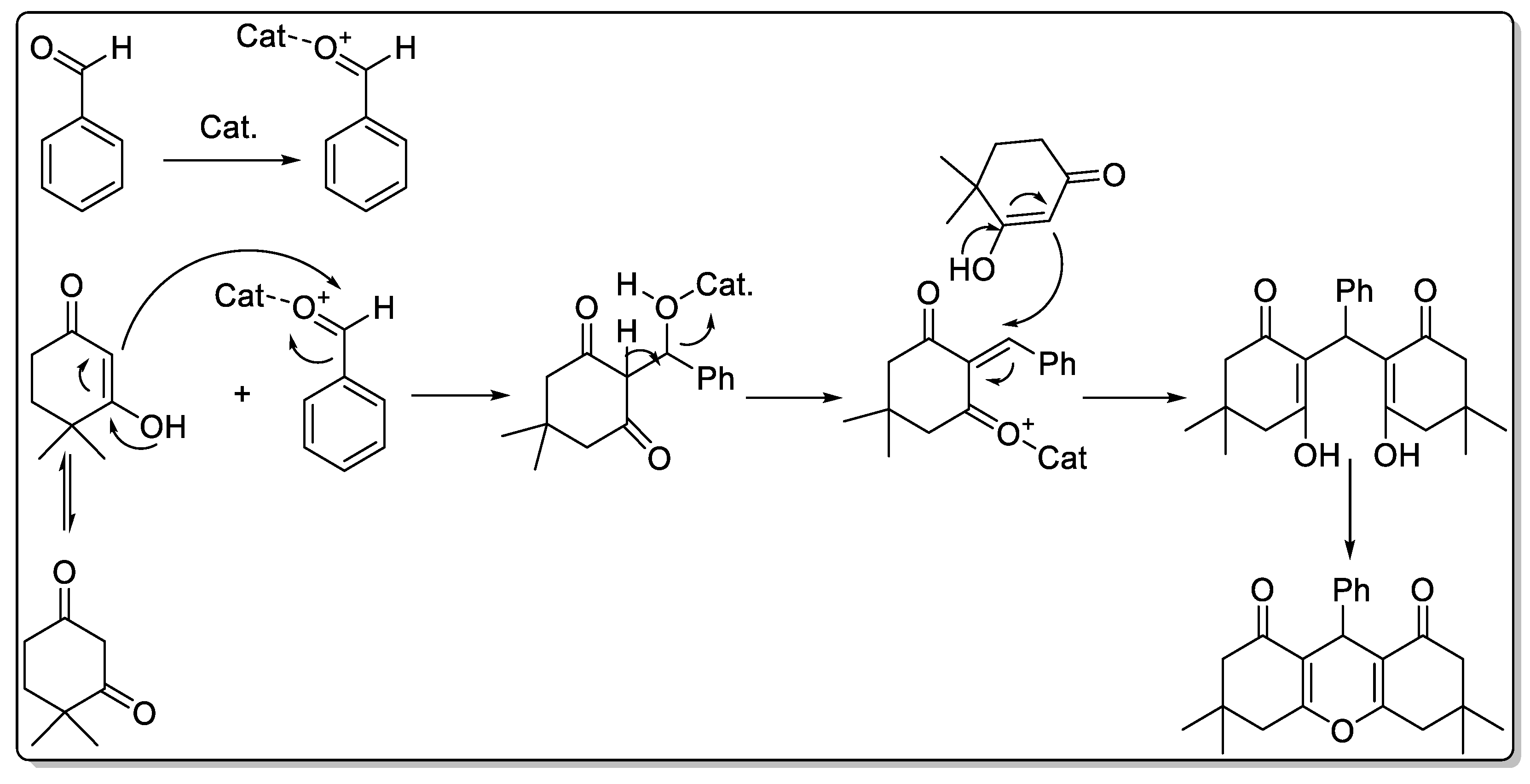
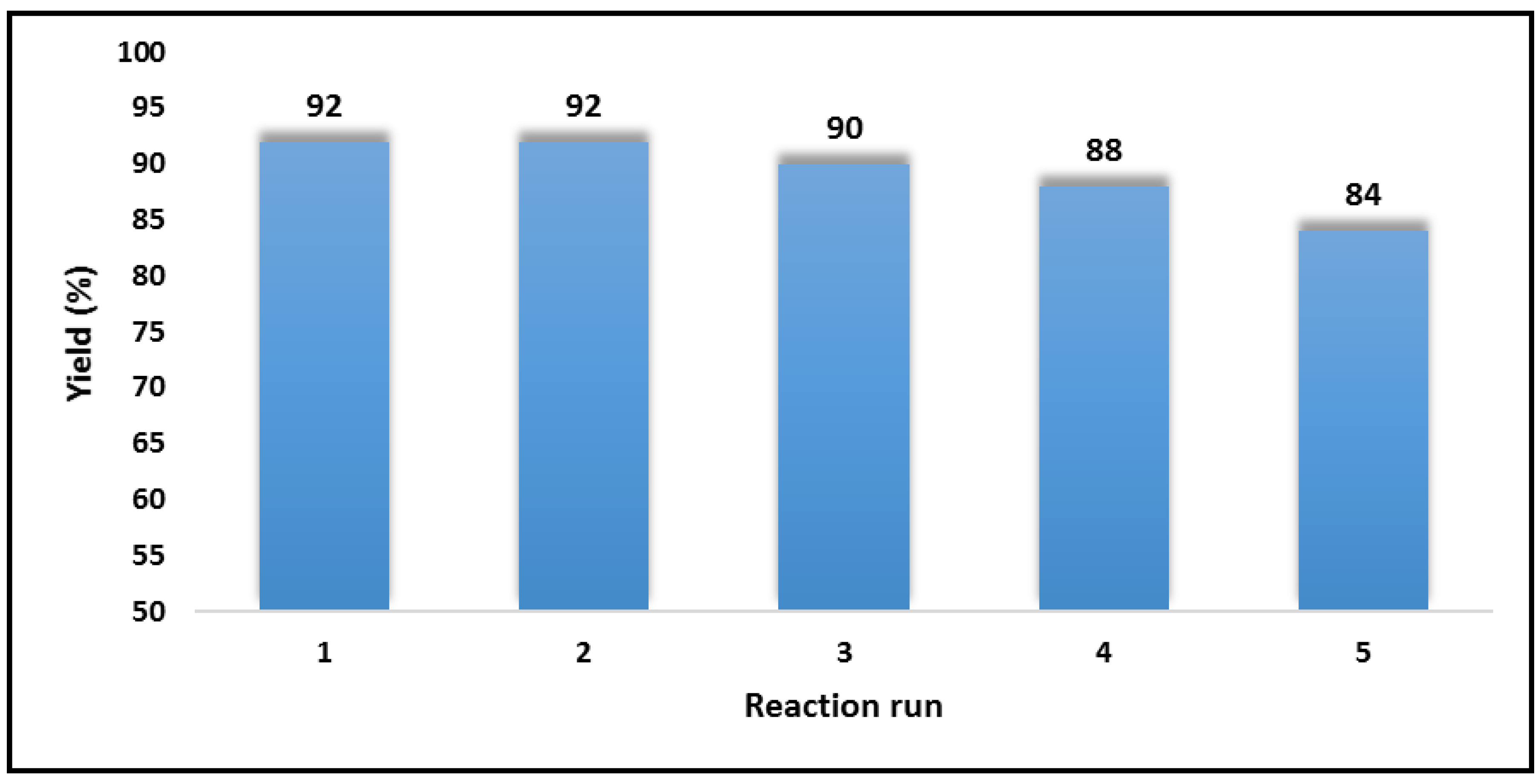
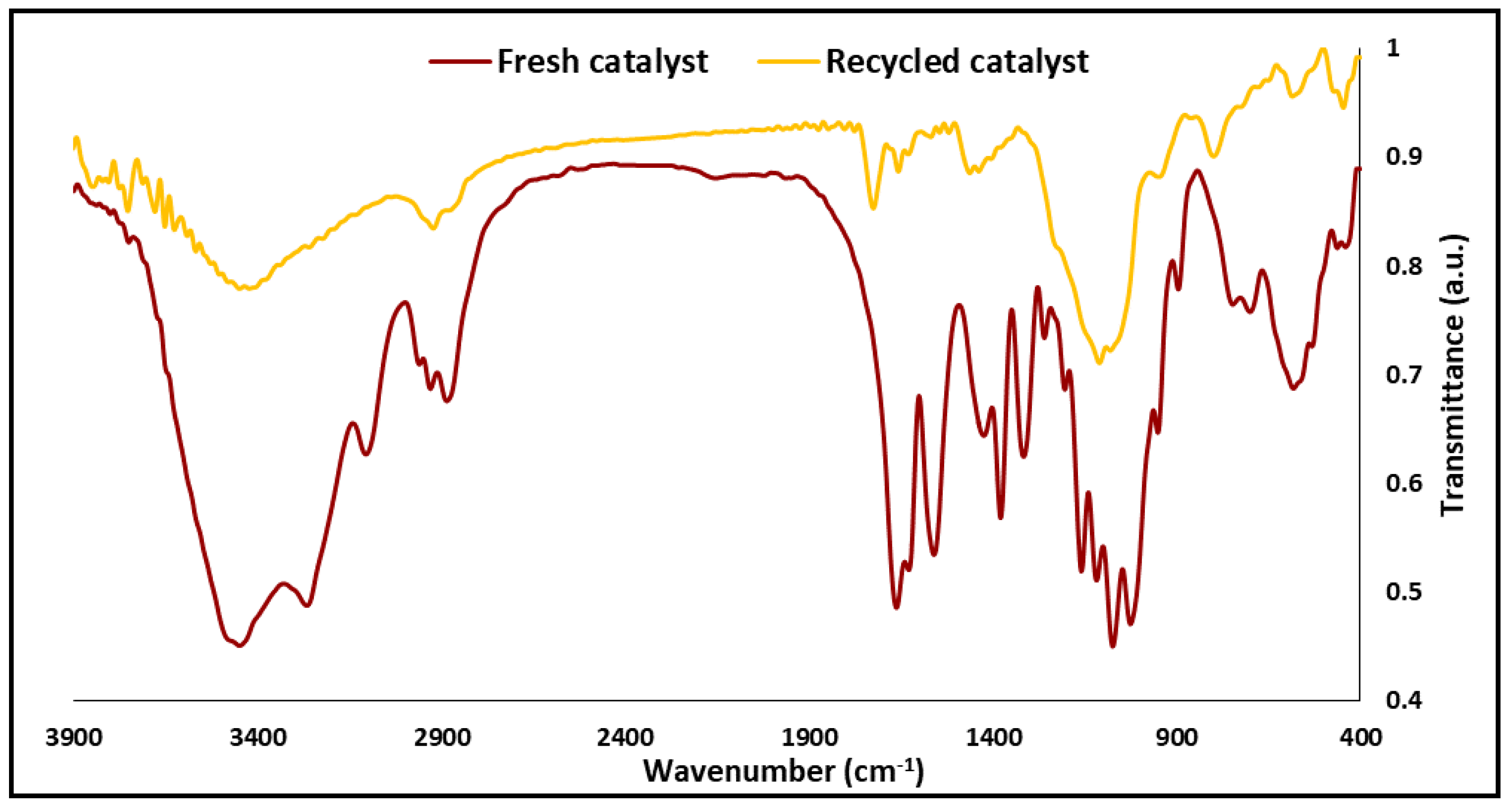
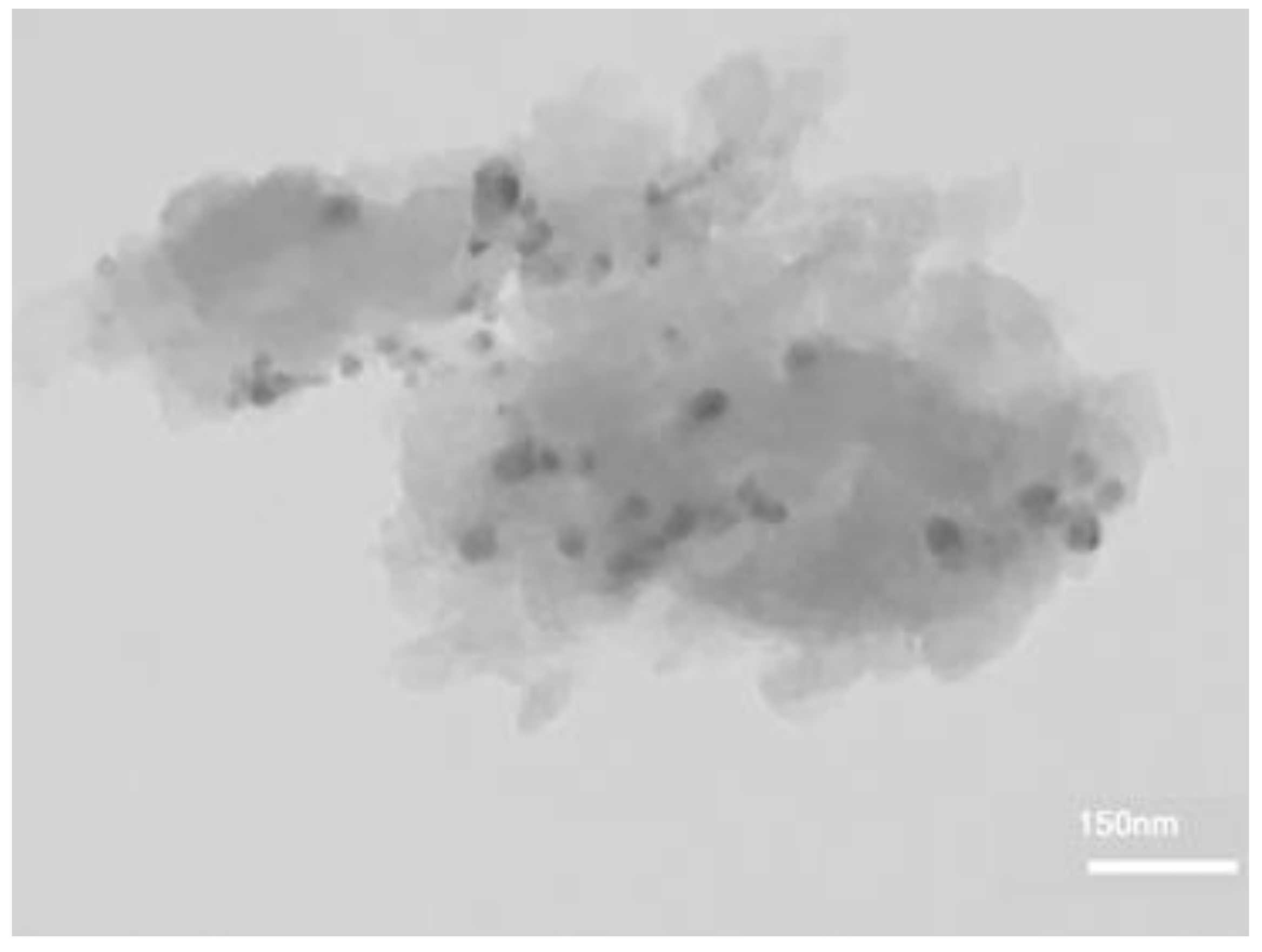

| Element | Weight (%) | Atomic (%) |
|---|---|---|
| C | 44.13 | 51.87 |
| N | 39.42 | 39.74 |
| O | 6.55 | 5.78 |
| Si | 0.82 | 0.41 |
| Cl | 3.04 | 1.21 |
| Ag | 5.19 | 0.68 |
| K | 0.86 | 0.31 |
| Entry | Solvent | Temp. (°C) | Catalyst Amount (g) | Yield (%) |
|---|---|---|---|---|
| 1 | H2O | 25 | 0.02 | 76 |
| 2 | EtOH | 25 | 0.02 | 79 |
| 3 | H2O:EtOH (1:2) | 25 | 0.02 | 80 |
| 4 | THF | 25 | 0.02 | 70 |
| 5 | CH3CN | 25 | 0.02 | 72 |
| 6 | H2O:EtOH (1:2) | 50 | 0.02 | 85 |
| 7 | H2O:EtOH (1:2) | 70 | 0.02 | 85 |
| 8 | H2O:EtOH (1:2) | 50 | 0.03 | 92 |
| 9 | H2O:EtOH (1:2) | 50 | 0.04 | 92 |
| Entry | Catalyst | Yield at Optimum Reaction Condition of the Catalyst (%) a | Yield at Optimum Reaction Condition of Each Control Sample (%) |
|---|---|---|---|
| 1 | Ag@CDNS | 70 | 78 b |
| 2 | Ag@CDNS-N | 70 | 78 b |
| 3 | Ag@PMelamine | 72 | 80 c |
| 4 | Ag@CDNS-N/PMelamine | 92 | 92 a |

| Entry | Substrate | Yield (%) a |
|---|---|---|
| 1 | Benzaldehyde | 92 |
| 2 | 4-NO2-benzaldehyde | 95 |
| 3 | 2-NO2-benzaldehyde | 93 |
| 4 | 4-Me-benzaldehyde | 98 |
| 5 | 4-MeO-benzaldehyde | 95 |
| 6 | 2-MeO-benzaldehyde | 90 |
| 7 | 4-Cl-benzaldehyde | 95 |
| 8 | Furfural b | 90 |
| Entry | Catalyst | Solvent | Time h:min | Temp. (°C) | Quantity | Yield (%) | Ref. |
|---|---|---|---|---|---|---|---|
| 1 | Ag@CDNS-N/PMelamine | H2O:EtOH | 03:00 | 50 | 0.03 g | 92 | - |
| 2 | Fe3O4@SiO2–SO3H | - | 00:4 | 110 | 0.05 g | 97 | [33] |
| 3 | Silica-bonded S-sulfonic acid (SBSSA) | EtOH | 10:00 | Reflux | 0.03 g | 98 | [34] |
| 4 | Nano-ZnO | - | 02:00 | 100 | 10 mol% | Trace | [32] |
| 5 | Barium Perchlorate | EtOH | 03:00 | Reflux | 15 mol% | 95 | [47] |
| 6 | Nano titania-supported sulfonic acid (n-TSA) | - | 01:10 | 90 | 0.013 g | 91 | [32] |
| 7 | Nano-NiO | - | 02:00 | 100 | 10 mol% | Trace | [32] |
| 8 | Fe2(SO4)3.7H2O | - | 01:30 | 120 | 10 mol% | 86 | [48] |
© 2020 by the authors. Licensee MDPI, Basel, Switzerland. This article is an open access article distributed under the terms and conditions of the Creative Commons Attribution (CC BY) license (http://creativecommons.org/licenses/by/4.0/).
Share and Cite
Sadjadi, S.; Ghoreyshi Kahangi, F.; Dorraj, M.; Heravi, M.M. Ag Nanoparticles Stabilized on Cyclodextrin Polymer Decorated with Multi-Nitrogen Atom Containing Polymer: An Efficient Catalyst for the Synthesis of Xanthenes. Molecules 2020, 25, 241. https://doi.org/10.3390/molecules25020241
Sadjadi S, Ghoreyshi Kahangi F, Dorraj M, Heravi MM. Ag Nanoparticles Stabilized on Cyclodextrin Polymer Decorated with Multi-Nitrogen Atom Containing Polymer: An Efficient Catalyst for the Synthesis of Xanthenes. Molecules. 2020; 25(2):241. https://doi.org/10.3390/molecules25020241
Chicago/Turabian StyleSadjadi, Samahe, Fatemeh Ghoreyshi Kahangi, Masoumeh Dorraj, and Majid M. Heravi. 2020. "Ag Nanoparticles Stabilized on Cyclodextrin Polymer Decorated with Multi-Nitrogen Atom Containing Polymer: An Efficient Catalyst for the Synthesis of Xanthenes" Molecules 25, no. 2: 241. https://doi.org/10.3390/molecules25020241
APA StyleSadjadi, S., Ghoreyshi Kahangi, F., Dorraj, M., & Heravi, M. M. (2020). Ag Nanoparticles Stabilized on Cyclodextrin Polymer Decorated with Multi-Nitrogen Atom Containing Polymer: An Efficient Catalyst for the Synthesis of Xanthenes. Molecules, 25(2), 241. https://doi.org/10.3390/molecules25020241





